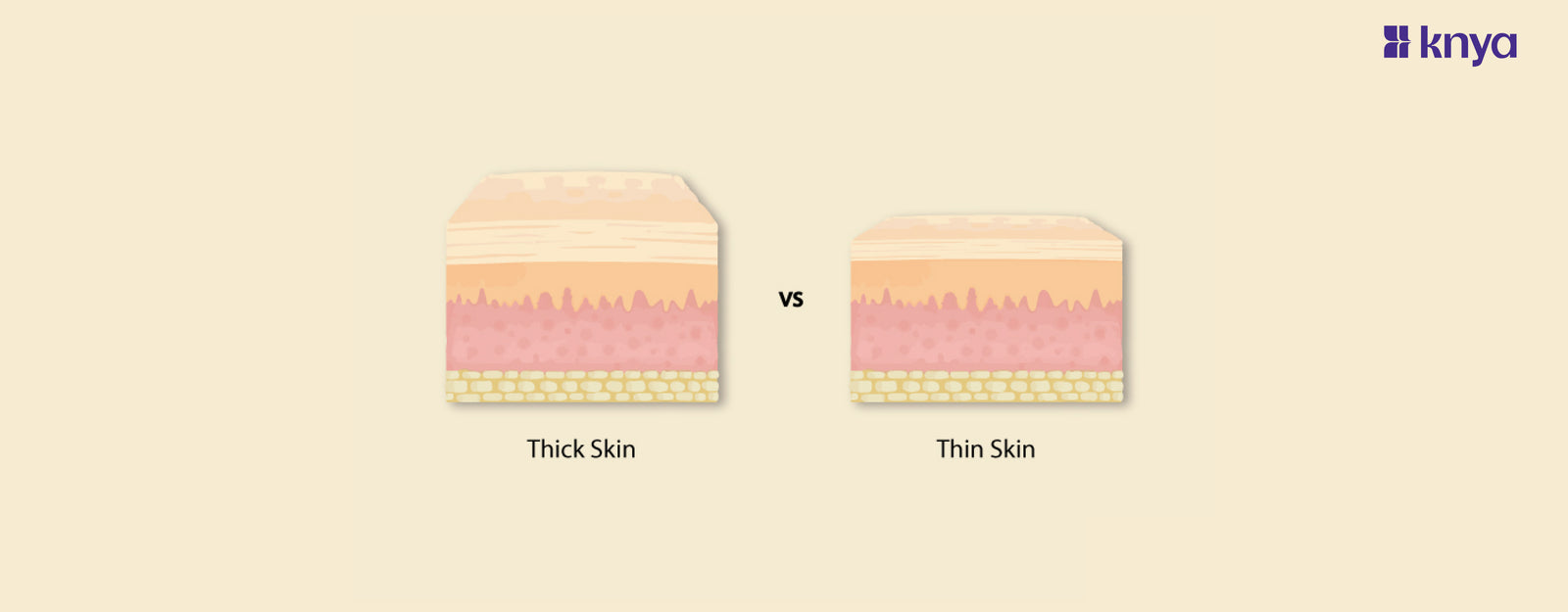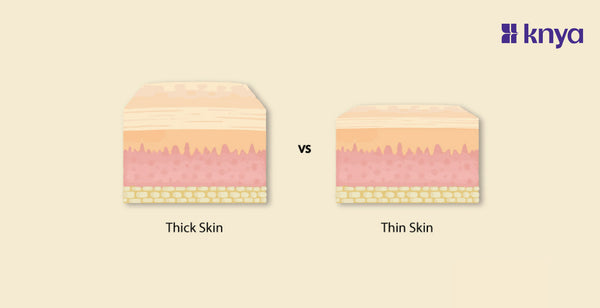The difference between thick and thin skin anatomy serves as a captivating chapter in anatomical studies. The skin, our body's largest organ, exhibits remarkable variations in thickness across different regions. Understanding the contrasting characteristics of thick and thin skin not only unravels the intricacies of human anatomy but also sheds light on the diverse functionalities and protective roles these variations play.
Navigating the Difference between thick and thin skin enriches our understanding of the body's adaptive strategies, emphasizing the intricate interplay between structure, function, and environmental demands within the realm of human anatomy.
Difference Between Thick And Thin Skin Anatomy
Here's a table summarizing the key difference between thick and thin skin anatomy:
|
Feature |
Thick Skin |
Thin Skin |
|
Epidermal Layers |
Five distinct layers, including stratum lucidum. |
Four layers, lacking the stratum lucidum. |
|
Distribution Across the Body |
Palms of hands and soles of feet. |
Covers the majority of the body. |
|
Presence of Hair and Glands |
Devoid of hair and sebaceous glands. |
Contains hair follicles, sebaceous, and sweat glands. |
|
Sensory Perception |
Less sensitive. |
More sensitive due to a rich network of sensory receptors and nerve endings. |
|
Keratinization and Functionality |
Robust keratinization for resilience. |
Less extensive keratinized layer, prioritizing flexibility and responsiveness. |
|
Thickness of Dermis |
Thicker dermal layer, contributing to durability. |
Thinner dermal layer, emphasizing flexibility. |
|
Protection and Wear Resistance |
Offers superior protection and wear resistance. |
Less resistant to abrasion, prioritizes flexibility. |
|
Eccrine Sweat Glands |
Present in limited areas. |
Distributed throughout, aiding in thermoregulation. |
|
Sebaceous Glands |
Lacks sebaceous glands. |
Contains sebaceous glands for lubrication. |
|
Stratum Corneum Thickness |
Thicker stratum corneum. |
Thinner stratum corneum. |
|
Location on the Body |
Limited to specific areas with high mechanical stress. |
Widespread, covering areas with varied stress levels. |
|
Histological Appearance |
Easily distinguishable histologically. |
Histologically less distinct due to fewer layers. |
|
Regeneration Capability |
Slower regeneration due to thicker layers. |
Faster regeneration due to fewer layers. |
Check out the Best Scrubs Suit Collection Here!
What is Thin Skin Anatomy
Thin skin refers to the type of skin found in the majority of the body, characterized by its relatively thinner structure compared to thick skin. It covers areas that are not subjected to as much mechanical stress or abrasion. Here are some key features of thin skin anatomy:
- Epidermal Layers: Thin skin has four distinct layers of the epidermis, which include the stratum basale, stratum spinosum, stratum granulosum, and stratum corneum. Unlike thick skin, it lacks the fifth layer known as the stratum lucidum.
- Distribution Across the Body: Thin skin is found throughout most areas of the body, including the arms, legs, trunk, and face. It is especially prevalent in regions where flexibility and sensitivity to stimuli are essential.
- Hair and Glands: Thin skin contains hair follicles, sebaceous glands, and sweat glands. These structures contribute to the adaptability and responsiveness of thin skin.
- Sensory Perception: Due to a rich network of sensory receptors and nerve endings, thin skin is more sensitive compared to thick skin. This heightened sensitivity allows for a greater tactile perception.
- Keratinization and Functionality: Thin skin has a less extensive keratinized layer compared to thick skin. This prioritizes flexibility and responsiveness over the robust protection provided by thick skin.
- Thickness of Dermis: The dermal layer in thin skin is relatively thinner compared to thick skin. This contributes to the overall flexibility of thin skin.
- Eccrine Sweat Glands: Thin skin has a distributed network of eccrine sweat glands, aiding in thermoregulation by producing sweat that evaporates from the skin's surface.
- Sebaceous Glands: Thin skin contains sebaceous glands that produce sebum, contributing to the lubrication and moisture of the skin.
- Stratum Corneum Thickness: The stratum corneum, the outermost layer of the epidermis, is thinner in thin skin compared to the thicker stratum corneum in thick skin.
- Location on the Body: Thin skin covers a wide range of body areas with varied stress levels, as it is not confined to regions subjected to constant mechanical stress.
Check about Lab Coats in Details
What is Thick Skin Anatomy
Thick skin refers to a specialized type of skin with a thicker structure found in specific regions of the body that are subjected to more significant mechanical stress and abrasion. Here are the key features of thick skin anatomy:
- Epidermal Layers: Thick skin has five distinct layers in the epidermis, including the stratum basale, stratum spinosum, stratum granulosum, stratum lucidum, and stratum corneum. The presence of the stratum lucidum sets it apart from thin skin.
- Distribution Across the Body: Thick skin is typically found in areas that endure more mechanical stress, such as the palms of the hands and the soles of the feet. These regions require additional protection against wear and tear.
- Hair and Glands: Thick skin lacks hair follicles and sebaceous glands, contributing to its resilience and durability. However, it does contain sweat glands, particularly eccrine sweat glands.
- Sensory Perception: Thick skin is less sensitive compared to thin skin due to the absence of hair follicles and a thinner sensory nerve network. This is advantageous in areas where protection is prioritized over heightened sensitivity.
- Keratinization and Functionality: The keratinized layer in thick skin is more robust, providing increased protection against mechanical stress and environmental factors. This thickness enhances the durability of the skin.
- Thickness of Dermis: The dermal layer in thick skin is thicker compared to thin skin, contributing to its overall toughness.
- Eccrine Sweat Glands: Thick skin contains eccrine sweat glands, which are important for thermoregulation by producing sweat that evaporates from the skin's surface.
- Sebaceous Glands: Thick skin lacks sebaceous glands, reducing the production of sebum. This absence contributes to a drier texture compared to thin skin.
- Stratum Corneum Thickness: The stratum corneum, the outermost layer of the epidermis, is thicker in thick skin. This thickness enhances the protective function of the skin.
- Location on the Body: Thick skin is localized to specific areas of the body that experience constant mechanical stress and abrasion, such as the palms and soles.
Understanding the unique features of thick skin is crucial for appreciating its specialized role in providing enhanced protection and resilience in areas that undergo constant wear and tear.
Similarity Between Thick And Thin Skin Anatomy
While there is a difference between thick and thin skin anatomy, they also share some common characteristics. Here are the similarities between thick and thin skin anatomy:
- Epidermal Origin:
- Both thick and thin skin originate from the epidermis, the outermost layer of the skin.
- Containment of Epidermal Layers:
- Both types of skin contain common epidermal layers, such as the stratum basale, stratum spinosum, and stratum granulosum. The stratum corneum is present in both, although its thickness varies.
- Presence of Sweat Glands:
- Both thick and thin skin house eccrine sweat glands, which play a crucial role in thermoregulation by producing sweat that evaporates from the skin's surface.
- Protection Against Ultraviolet (UV) Radiation:
- Both types of skin provide a degree of protection against harmful ultraviolet (UV) radiation from the sun, with melanocytes in the epidermis contributing to pigmentation.
- Responsiveness to External Stimuli:
- Both thick and thin skin exhibit responsiveness to external stimuli, including temperature changes, pressure, and tactile sensations. Nerve endings in the skin contribute to sensory perception.
- Containment of Blood Vessels:
- Both skin types contain blood vessels in the dermal layer, contributing to nutrient supply and temperature regulation.
- Barrier Function:
- Both thick and thin skin serve as a protective barrier against pathogens, preventing the entry of microorganisms and reducing the risk of infection.
- Continuous Regeneration:
- Both types of skin undergo continuous regeneration, with cells in the stratum basale dividing and migrating towards the surface to replace old, worn-out skin cells.
- Contributions to Homeostasis:
- Both skin types contribute to maintaining homeostasis by regulating body temperature through sweating, protecting against external threats, and participating in sensory perception.
While difference between thick and thin skin anatomy in their specific characteristics and locations on the body, their commonalities underscore the fundamental functions of the integumentary system in providing protection, sensation, and homeostasis.
|
Check out More Articles |
|















